paleomaxx
Hero Member
- Joined
- Aug 14, 2016
- Messages
- 841
- Reaction score
- 6,888
- Golden Thread
- 6
- Location
- Upstate, NY
- 🥇 Banner finds
- 6
- Detector(s) used
- Deus XP
- Primary Interest:
- All Treasure Hunting
Yup, just sitting pretty wedged between some rocks in an old foundation:
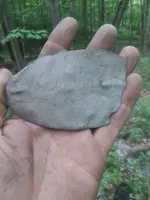
Didn't even need the shovel, I just pulled two of the huge slate slabs apart and it fell out of the crack. Based on the signal I was expecting some iron sheet, and when I first picked it up I thought it was instead brass flashing, but then the light hit the engravings and I saw the 1775!
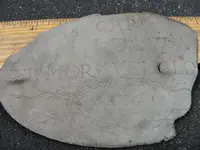
I don't have all the details on this yet as information seems to be tough to come by on these pieces and odds are this was custom made. The top says Captain and I presume the "ID" underneath are initials. 1775 may be the date of enlistment/commissioning and the Latin motto is partial but what's there reads "Vel Mors Vel Glo-" Vel Mors Vel Gloria was my first guess as to the whole motto which (while not proper Latin) could be translated to "death or glory." The wreath clearly shows "9th Reg" for 9th Regiment. Based on the motto and where this was recovered (Massachusetts) I'm leaning towards this being an American as opposed to British plate. I'm open to discussion though...
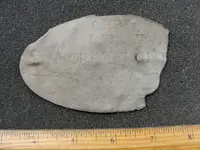
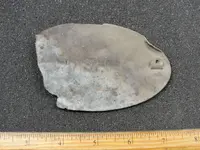
This is without a doubt a find of a lifetime for me! I've been hoping to find even a Rev War era military button this year, and I skipped right over that and then kept on skipping far past what my wildest expectations. Not just that, but being kept out of the dirt all these years it's in nearly immaculate condition and all of those detailed engravings are still as sharp as the day the were cut 245 years ago!
It seems almost silly to mention, but there were a handful of other associated finds around the foundation.
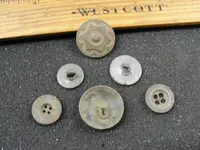
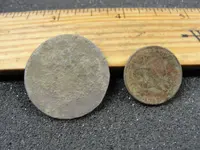
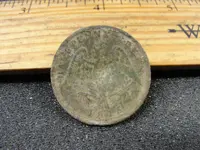
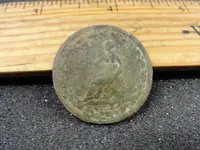
I'm positive I wasn't the first to detect this homestead as there were iron bits on rocks and around trees. Very few signals in the ground, but the tombacs and coppers at least confirm that this homesite was likely late 18th century and thus the plate was probably lost by the original owner or a close relative. The 1815 halfpenny token was a first for me and the 1857 flying eagle is in decent shape. The site being 18th century also means the missing piece may be around somewhere, but I didn't have any luck finding it today.
I'd be very interested to hear what people think on the plate, and if anyone can dig up roster information from the 9th regiment. There couldn't have been that many captains and if the initials really are "ID" it would be amazing to attribute this to a specific individual. There don't seem to be many examples of box plates from this time period out there so I'm not even sure if this is a typical layout and if having the motto in there is an unusual addition or a common practice.
Obviously time for more research, but talk about holding a piece of history in your hands...
UPDATE, CONCLUSIVELY ATTRIBUTED!!!
Well this took some serious research and some significant guidance in the right direction from some members of the facebook group suggested by Steve in PA, but I got it! The first break came from a small excerpt in the Twentieth Report of the National Society of the Daughters of the American Revolution (1916-1917). That had a little blurb:
Captain Jonathan Danforth would match the initials and was in a 9th regiment so I dug a little deeper. The big break was in the book A History of the Town of Pittsfield in Berkshire County Mass (1844). That had an extensive biography of Colonel Joshua Danforth who had an incredible career during the revolutionary war starting as a clerk and was eventually made a colonel, but most importantly it mentioned that he served with his father's company starting in 1775:
Pretty amazing, and the mentions of his father's service gave me enough to go on that I finally found a short biography of Jonathan Danforth:
And there you have it! This piece belonged to Captain Jonathan Danforth who was not only at the Battle of Bunker Hill, but had a significant role in the Battle of Bennington and this may very well have been with him at both! Talk about a one-of-a-kind piece of history folks!!!

Didn't even need the shovel, I just pulled two of the huge slate slabs apart and it fell out of the crack. Based on the signal I was expecting some iron sheet, and when I first picked it up I thought it was instead brass flashing, but then the light hit the engravings and I saw the 1775!


I don't have all the details on this yet as information seems to be tough to come by on these pieces and odds are this was custom made. The top says Captain and I presume the "ID" underneath are initials. 1775 may be the date of enlistment/commissioning and the Latin motto is partial but what's there reads "Vel Mors Vel Glo-" Vel Mors Vel Gloria was my first guess as to the whole motto which (while not proper Latin) could be translated to "death or glory." The wreath clearly shows "9th Reg" for 9th Regiment. Based on the motto and where this was recovered (Massachusetts) I'm leaning towards this being an American as opposed to British plate. I'm open to discussion though...


This is without a doubt a find of a lifetime for me! I've been hoping to find even a Rev War era military button this year, and I skipped right over that and then kept on skipping far past what my wildest expectations. Not just that, but being kept out of the dirt all these years it's in nearly immaculate condition and all of those detailed engravings are still as sharp as the day the were cut 245 years ago!
It seems almost silly to mention, but there were a handful of other associated finds around the foundation.




I'm positive I wasn't the first to detect this homestead as there were iron bits on rocks and around trees. Very few signals in the ground, but the tombacs and coppers at least confirm that this homesite was likely late 18th century and thus the plate was probably lost by the original owner or a close relative. The 1815 halfpenny token was a first for me and the 1857 flying eagle is in decent shape. The site being 18th century also means the missing piece may be around somewhere, but I didn't have any luck finding it today.
I'd be very interested to hear what people think on the plate, and if anyone can dig up roster information from the 9th regiment. There couldn't have been that many captains and if the initials really are "ID" it would be amazing to attribute this to a specific individual. There don't seem to be many examples of box plates from this time period out there so I'm not even sure if this is a typical layout and if having the motto in there is an unusual addition or a common practice.
Obviously time for more research, but talk about holding a piece of history in your hands...
UPDATE, CONCLUSIVELY ATTRIBUTED!!!
Well this took some serious research and some significant guidance in the right direction from some members of the facebook group suggested by Steve in PA, but I got it! The first break came from a small excerpt in the Twentieth Report of the National Society of the Daughters of the American Revolution (1916-1917). That had a little blurb:
Bowen, Jabesh. He was a corporal in Capt. Jonathan Danforth’s company, Col. Daniel Brewer’s Ninth regiment.
Captain Jonathan Danforth would match the initials and was in a 9th regiment so I dug a little deeper. The big break was in the book A History of the Town of Pittsfield in Berkshire County Mass (1844). That had an extensive biography of Colonel Joshua Danforth who had an incredible career during the revolutionary war starting as a clerk and was eventually made a colonel, but most importantly it mentioned that he served with his father's company starting in 1775:
Col. Joshua Danforth, to use the language of the Rev. Dr. Brinsmade, in the sermon preached at his funeral, “was born in Western, [now Warren,] Massachusetts, November 26th, 1759. He was the son of Jonathan Danforth, an officer in the Revolutionary War, who acted a conspicuous part as commander of a battalion in the Battle of Bennington. It was the intention of his father, in early life, to give this son a liberal education and he was qualifying himself to enter College when the Revolutionary struggle commenced. It was then, when the note of war was sounded and the veteran troops of England were pouring in upon our territories, that, at the age of fifteen years, he entered the army in the capacity of clerk in his father’s company. After having served several months in this office, at the same time discharging the duties of Surgeon’s mate, he received, at the age of sixteen, an Ensign’s commission. From this post he was promoted, and in 1778 raised to the rank of first Lieutenant, in which office he continued until 1781, when he was appointed Paymaster, with the rank of Captain.
His first active services were performed at Roxbury, in June, 1775, at the time the British were throwing bombs into that place. When General Washington had ordered the army to remove from that place, and the last regiment had left the encampment, it was ascertained that a part of the baggage had been left behind, and a detachment of men, under the command of Mr. Danforth, was ordered to go and secure it, which was done at great hazard. He remained in that vicinity until March 17, 1776, when, with the main body of the American army under Washington, he marched into Boston, as the rear of the British army left that town. He was in Boston until the following summer, and there in July heard for the first time the Declaration of Independence read to the army, which was called out for that purpose. Soon after this he went to Ticonderoga, and was at the surrender of Burgoyne in 1777. Immediately after this event, the Brigade to which he belonged was ordered to New Jersey, and thence to White Marsh; and on the 19th of December the army took up their winter quarters at Valley Forge, about twenty miles from Philadelphia, which was then in the possession of the British. It was on this march, the historian tell us that “through want of shoes and stockings, over the hard frozen ground, the army might be tracked from White Marsh to Valley Forge, by the blood from their feet.” Colonel Danforth has been heard to say that the suffering of the army from want of food and shelter that winter were incredible.
In 1778 he was in the battle of Monmouth, and the August of the following he went to Rhode Island. He spent the principle part of the year 1780 at West Point and its vicinity. In 1781 he had command, for some months, of a post a few miles from the Hudson near Tappan’s Bay, and was engaged in several skirmishes with the enemy. The army was disbanded in 1783, but Colonel Danforth was continued in the service as Paymaster, to assist in the settlement of the accounts with the soldiers, and was not discharged until the year following.
Pretty amazing, and the mentions of his father's service gave me enough to go on that I finally found a short biography of Jonathan Danforth:
Jonathan Danforth (1736-1802) was a minute man at Bunker Hill and with him were his two sons, Joshua and Jonathan, Jr. He commanded a battalion at the battle of Bennington.
And there you have it! This piece belonged to Captain Jonathan Danforth who was not only at the Battle of Bunker Hill, but had a significant role in the Battle of Bennington and this may very well have been with him at both! Talk about a one-of-a-kind piece of history folks!!!
Last edited:
Upvote
123




